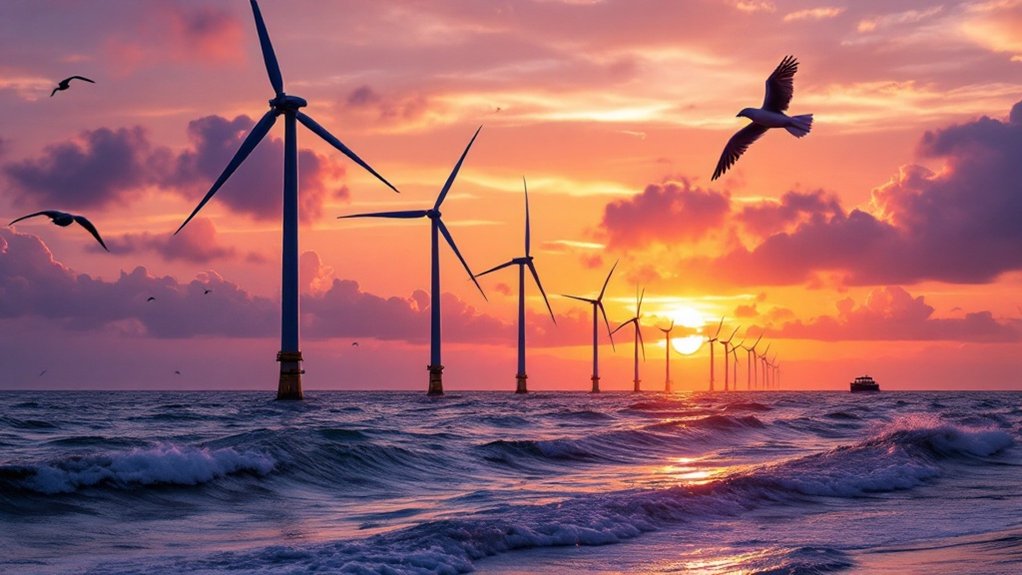
Why Offshore Wind Power Is the Future
Offshore wind power represents a significant opportunity for renewable energy generation. Its ability to harness stronger winds in deeper waters enhances energy production potential. As the global demand for sustainable solutions increases, offshore wind offers a path toward reducing carbon emissions. However, the industry faces various challenges that must be addressed. Understanding the complexities of this evolving sector reveals insights into its future viability and impact on the energy landscape.
The Environmental Benefits of Offshore Wind Power
Although concerns about energy production often center on environmental impacts, offshore wind power emerges as a promising solution that greatly benefits the ecosystem. This renewable energy source generates electricity without depleting natural resources or emitting harmful greenhouse gases. By harnessing the wind over the ocean, it minimizes land use and preserves habitats onshore. Furthermore, offshore wind farms can enhance marine biodiversity, as the structures often create artificial reefs that attract various marine organisms. They also contribute to cleaner air and water by reducing reliance on fossil fuels. The shift towards offshore wind power signifies a commitment to sustainable energy practices, aligning with global efforts to combat climate change while fostering healthier ecosystems. Additionally, the renewable energy sector is a significant source of job creation, further enhancing the positive impact of offshore wind power.
Economic Growth and Job Creation in the Offshore Wind Industry
As the demand for renewable energy continues to rise, the offshore wind industry stands out as a catalyst for economic growth and job creation. This sector generates a multitude of employment opportunities, ranging from manufacturing and installation to maintenance and operations. As new offshore wind projects are developed, local economies benefit from increased investment and infrastructure development. The creation of skilled jobs in engineering, construction, and environmental management stimulates workforce growth and encourages community engagement. Additionally, the offshore wind industry fosters innovation and supports supply chain development, which further solidifies its impact on the economy. By harnessing wind energy, nations can not only meet sustainability goals but also stimulate economic resilience and prosperity in coastal regions. Sustainable practices such as reducing energy consumption are essential for maximizing the benefits of this industry.
Technological Advancements Driving Offshore Wind Energy
The offshore wind industry is increasingly shaped by technological advancements that enhance efficiency and reduce costs. Innovations in turbine design, such as larger rotor diameters and higher capacities, allow for greater energy production from fewer installations. Additionally, advancements in floating wind farm technology enable deployment in deeper waters, revealing previously inaccessible wind resources. Enhanced predictive maintenance tools, utilizing artificial intelligence and machine learning, improve operational reliability and reduce downtime. Moreover, innovations in installation methods, including the use of specialized vessels, streamline the construction process. These technological developments not only lower the levelized cost of energy but also bolster the overall feasibility and sustainability of offshore wind projects, making them a pivotal component of the global renewable energy landscape. Practicing mindfulness techniques can also help stakeholders remain focused and present as they navigate the complexities of this evolving industry.
Challenges and Solutions in Offshore Wind Development
While the offshore wind sector offers significant potential for renewable energy generation, it also faces a range of challenges that can hinder development. Key obstacles include high initial investment costs, complex regulatory frameworks, and logistical issues related to installation and maintenance in marine environments. Additionally, environmental concerns and opposition from local communities may complicate project approval processes. To address these challenges, stakeholders are exploring innovative financing models, streamlining regulatory procedures, and investing in advanced technologies that enhance operational efficiency. Collaboration among governments, private entities, and researchers is essential to develop best practices and create supportive policies. By tackling these issues head-on, the offshore wind industry can reveal its full potential and contribute meaningfully to global renewable energy targets. Furthermore, hybrid work models are being adopted by organizations to support remote work opportunities for employees involved in the sector.
The Future Outlook for Offshore Wind Power Globally
A noteworthy transformation in the energy landscape is anticipated as offshore wind power gains momentum worldwide. Projections indicate that the global offshore wind capacity could reach over 200 gigawatts by 2030, driven by technological advancements and supportive policies. Countries like the United States, China, and several European nations are investing considerably in offshore projects, recognizing their potential to reduce carbon emissions and enhance energy security. Furthermore, innovations in turbine efficiency and energy storage solutions are expected to lower costs and improve reliability. As the industry matures, international collaboration may foster knowledge sharing and accelerate deployment. Consequently, offshore wind power is poised to play a pivotal role in the shift to sustainable energy systems globally, contributing to climate targets and economic growth. Additionally, AI technology is being leveraged to optimize energy production and grid management in offshore wind farms.
Frequently Asked Questions
How Does Offshore Wind Power Affect Marine Wildlife?
Offshore wind power installations can impact marine wildlife through habitat alteration, noise pollution, and potential collision risks. However, studies indicate that with careful planning, negative effects can be minimized, promoting coexistence of energy generation and marine ecosystems.
What Are the Costs Associated With Offshore Wind Farms?
The costs associated with offshore wind farms include initial capital investment, installation, maintenance, and operational expenses. These factors can vary considerably based on location, technology, and regulatory frameworks, influencing overall project viability and long-term returns.
How Do Offshore Wind Turbines Compare to Onshore Turbines?
Offshore wind turbines typically generate more energy due to stronger and more consistent winds compared to onshore turbines. However, they face higher installation and maintenance costs, alongside challenges related to accessibility and environmental impacts.
What Is the Lifespan of an Offshore Wind Turbine?
The lifespan of an offshore wind turbine typically ranges from 20 to 25 years, depending on various factors such as design, maintenance, and environmental conditions, ensuring a sustainable energy source throughout its operational life.
Are There Any Safety Concerns With Offshore Wind Energy?
Offshore wind energy presents certain safety concerns, including risks during installation and maintenance, potential impacts on marine wildlife, and navigational hazards for vessels. Addressing these issues is vital to guarantee safe and sustainable offshore wind operations.
Conclusion
To sum up, offshore wind power stands as a pivotal solution for a sustainable energy future, offering substantial environmental benefits alongside economic growth and job creation. Technological advancements continue to enhance the efficiency and viability of offshore projects, while addressing the inherent challenges. As global demand for renewable energy escalates, the offshore wind sector is poised to play a critical role in mitigating climate change and fostering a resilient, clean energy landscape for generations to come.



